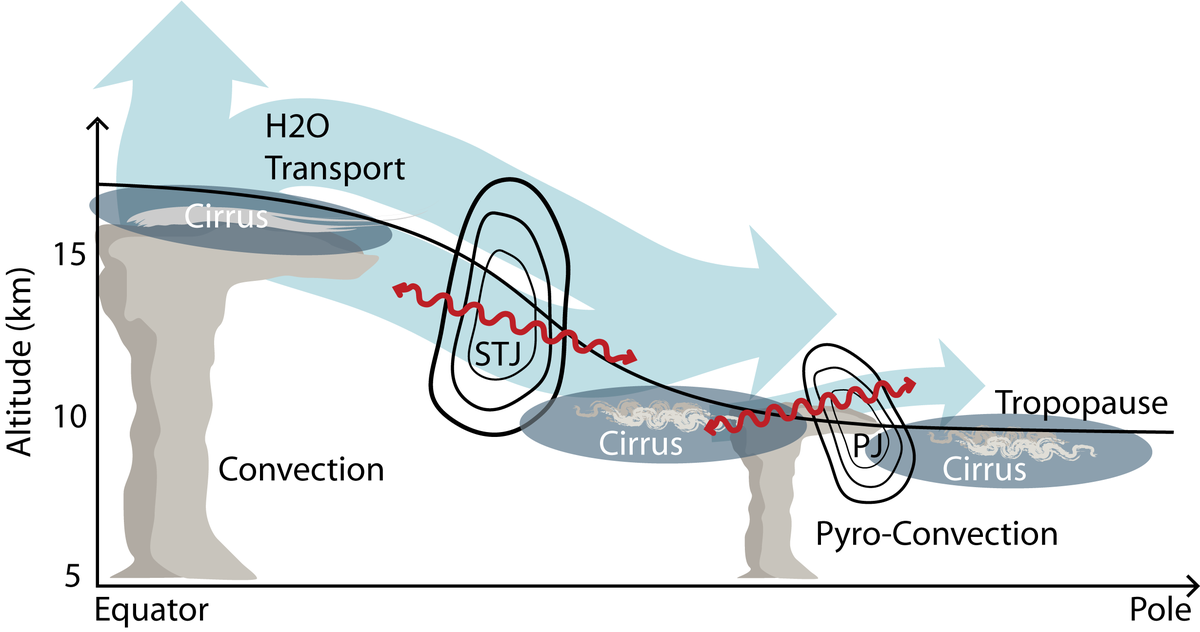Water vapor variability and trends
About
Radiative balance refers to the equilibrium between the amount of energy from the sun that the Earth receives and the amount of energy that the Earth radiates back into space. When this balance is maintained, the Earth’s surface temperature remains relatively stable. However, changes in the upper troposphere and stratosphere (UTS) at altitudes of 10 to 50km in greenhouse gases like water vapor or water in the condensed form such as cirrus clouds (ice clouds) can disrupt this balance, causing an energy imbalance and leading to a warming or cooling of the Earth’s surface. A quantitative understanding is crucial because small changes in the radiative balance can cause significant changes in the Earth’s climate system.
Water vapor is the most significant natural greenhouse gas in the atmosphere, and even though its concentrations are very low in the stratosphere, it contributes significantly to the climate feedback. It is transported from the troposphere into the stratosphere via small to large scale mixing and transport processes and is further distributed via the Brewer-Dobson Circulation. During transport, the water vapor content can change further due to the formation of cirrus clouds in particularly cold areas. Cirrus clouds absorb the Earth’s long-wave thermal radiation, causing an overall warming of the Earth. However, the radiation properties depend on the properties of the ice particles, the altitude and the thickness of the cirrus cloud and can even reverse the climatic influence from warming to cooling. The uncertainties in variations and trends in stratospheric water vapor and upper tropospheric cirrus clouds are a significant source of uncertainty in decadal climate variability and future predictions.
Research Topics
Research at ICE-4 focuses on advancing the understanding of processes resulting in variability and trends by using coherent measurement and modelling approaches. The variability in stratospheric water vapor is related on the one hand to dynamical features like the Asian summer monsoon which can significantly moisten the lower stratosphere by 15 and 30% in summer (Rolf et al., 2018). These processes result in a robust positive water vapor trend in the lower stratosphere after the year 2000 (Konopka et al., 2022), implying that water vapor feedbacks are already active in the current climate. The representation of cirrus clouds in global climate models can be improved with an extended knowledge of their properties and their geographical distribution. The microphysics of cirrus clouds has been studied based on aircraft in-situ and satellite remote sensing and is supporting model development activities. ICE-4 has gathered the world’s largest in-situ data base on cirrus clouds and water vapor measurements in the upper troposphere and lower stratosphere (UTLS) resulted in the ‘Cirrus Guide II’ (Kraemer et al., 2020).

Selection of ICE-4 publications
- Konopka, P. et al. (2022), Stratospheric Moistening After 2000, Geophys. Res. Lett., 49, e2021GL097609, doi:10.1029/2021GL097609.
- Krämer, M, et al. (2020), A microphysics guide to cirrus – Part 2: Climatologies of clouds and humidity from observations, Atmos. Chem. Phys., 20, 12569–12608, doi:10.5194/acp-20-12569-2020
- Rolf, C., et al., (2018), Water vapor increase in the lower stratosphere of the Northern Hemisphere due to the Asian monsoon anticyclone observed during the TACTS/ESMVal campaigns, Atmos. Chem. Phys., 18 2973-2983, doi:10.5194/acp-18-2973-2018.

